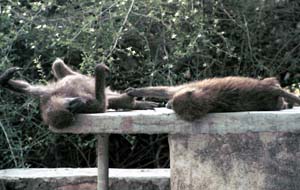It’s not that the food you eat is unimportant, but when it comes to the risk of obesity and diabetes, food may be less important than exercise. That’s the conclusion of studies by an international team of researchers involving baboons in Africa.

Investigators from Washington University and Saint Louis, Princeton and Stanford universities reported their findings in the March issue of the Journal of Clinical Endocrinology and Metabolism.
The researchers and their colleagues have been studying the eating and exercise patterns of two groups of wild baboons in East Africa. Like most primates, one group has to wander and forage for food. The other group lives near a tourist lodge in Kenya; it gets most of its food from the garbage dump.
Some of the baboons near the dump have become obese, resistant to insulin and developed a condition comparable to diabetes in humans — just like some people who eat too much and exercise too little. They have a condition similar to a human disorder called Syndrome X. Human patients with the syndrome are obese and have diabetes, high cholesterol and high blood pressure.
Obesity is rare in wild baboons, but it’s not unheard of in captive animals. In their initial study on leptin levels in wild animals, the Saint Louis University team members analyzed blood samples from wild baboons captured in Ethiopia by Jane E. Phillips-Conroy, Ph.D., of Washington University and Cliff Jolly, Ph.D., of New York Uni-versity.
When levels of leptin — a hormone that plays a role in obesity by affecting both appetite and calorie burning — from the Ethiopian baboons were compared with leptin levels in captive baboons from a colony in San Antonio, Texas, the two groups showed dramatic differences.

That study demonstrated that being in captivity was a risk factor for obesity, but when trying to extrapolate the data to better understand the problem of obesity in humans, a major obstacle was finding a comparison group of contemporary people who live in wild, aboriginal conditions.
“The next best thing is to go to the primate record,” said Phillips-Conroy, professor of anatomy in the School of Medicine and of anthropology in Arts & Sciences. “We share many features of biology and diet. This study illustrates the very productive marriage that can occur when biomedical scientists collaborate with field primatologists.”
In the field, primatologists like Phillips-Conroy learn a lot about how baboons live. She regularly gathers biological data by capturing and tranquilizing animals to draw blood samples. She also observes behavior and often knows a baboon’s age or can identify the animal’s mother and siblings.
In the new study, two baboon groups under study in Kenya for several decades by Princeton’s Jeanne Altmann and her colleagues made up a natural experiment. One had an easy food source, but the other had to work for food.
“When compared to typical baboons, these just sort of rolled out of their trees in the morning, sauntered over to the garbage dump and sat there waiting for food to arrive,” Phillips-Conroy said.
That’s not normal baboon behavior. Typically, they come down from trees in the morning and sit, groom and socialize. Then they spend the majority of their day walking from place to place, finding food. It’s a very energy-intensive lifestyle that’s a matter of necessity — a necessity that doesn’t exist for the “couch baboons” near the garbage dump.
“Baboons and other primates take advantage of human-created situations of abundance,” Altmann said. “The animals add these foods to their diets if they are in the territory they normally cover while looking for food, or they might shift their range to incorporate an abundant food source, somewhat like bears or deer in this country.”
By incorporating the garbage dump into their range, the baboons increased their risk of obesity, and some got fat.
“Altmann’s group previously found that more than a third of the baboons that didn’t have to work as much to get their food had indications of obesity, evidence of early diabetes caused by insulin resistance and elevated cholesterol levels,” said lead author William A. Banks, M.D., professor of geriatrics and pharmacological and physiological science at Saint Louis University School of Medicine.
Originally, the researchers thought the obesity was caused by the high-fat content of some foods from the garbage dump: cake, porridge and other foods not normally part of a baboon’s diet. But a closer look by Kenyan researcher Philip Muruthi, Ph.D., showed that the couch baboons actually were consuming about the same amount of calories and fat as the other baboons in the study. The real problem was that the couch baboons weren’t getting as much exercise as their wild brethren.
“Muruthi found that these baboons spent about a third to a quarter less time in food acquisition, which for baboons is what they spend most of their day doing,” Phillips-Conroy said. “In foraging for food, a baboon might roam up to six miles every day, but the couch baboons only traveled 1-3 miles. They didn’t have to move to get their food, and that seems to have been the critical thing.”
But not all of them got fat. That suggests some of the baboons might have been at higher risk for obesity and diabetes than others.
“The implication for humans is that some people can get away with indiscretions such as not exercising and will gain a little weight without suffering these serious health consequences,” Banks said. “Other people are going to balloon out and get sick with less provocation.”